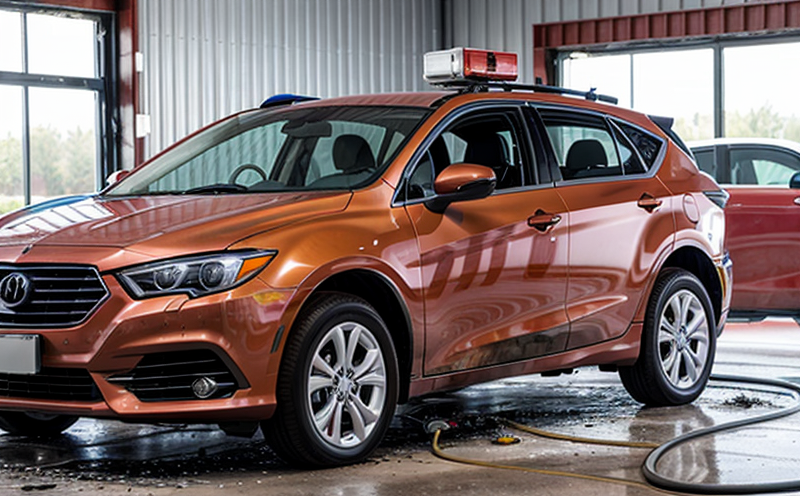Automotive Fire Safety Testing
The automotive industry is continually evolving to meet stringent safety standards and regulatory requirements. Automotive fire safety testing plays a crucial role in ensuring that vehicles, components, and materials are capable of withstanding the harsh conditions they may encounter during use. This service ensures compliance with international standards such as ISO 6930-2, ASTM E1354, EN 50187, and IEC 61967, which govern fire safety testing.
Our comprehensive testing services encompass a range of scenarios designed to replicate real-world conditions. These include evaluating ignition resistance, flame spread, heat release rates, and other critical parameters that determine the fire performance of automotive components such as seat materials, interior trim, structural parts, and electrical systems. By adhering to these standards, we help manufacturers achieve optimal safety while enhancing product design.
The testing process begins with detailed specimen preparation tailored to the specific material or component being tested. This involves cleaning, conditioning, and sometimes even replicating the actual assembly conditions. Once prepared, specimens undergo rigorous testing using specialized apparatus designed for automotive fire safety. Key equipment includes cone calorimeters, thermogravimetric analyzers (TGA), oxygen index testers, and smoke generators.
Testing parameters are carefully selected based on the type of material or component being evaluated. For instance, when assessing seat materials, we focus on flame spread ratings, heat release rates, and smoke density. These metrics provide critical insights into how a material behaves under fire conditions, helping manufacturers make informed decisions about their product designs.
Our team of expert engineers and technicians ensures accurate and repeatable results through precise control over test variables such as temperature, humidity, and airflow. This meticulous approach guarantees that the data generated is reliable and can be used to inform continuous improvement efforts. The final step in the process involves detailed reporting, which includes a comprehensive analysis of all test parameters, along with recommendations for enhancing fire safety.
By offering this service, we contribute significantly to the development of safer vehicles, reducing the risk of fires and ensuring compliance with global standards. This not only enhances public safety but also supports manufacturers in meeting increasingly stringent regulatory requirements.
Customer Impact and Satisfaction
Our focus on quality and customer satisfaction is reflected in our automotive fire safety testing services. By providing accurate, reliable, and repeatable test results, we ensure that our customers can make informed decisions about their product designs. This service not only helps manufacturers achieve compliance with international standards but also enhances the overall safety of vehicles.
Customer feedback plays a crucial role in shaping our offerings. We actively seek input from clients to understand their specific needs and challenges. Based on this feedback, we continuously refine our testing protocols and methodologies. Our goal is to offer services that meet or exceed customer expectations, fostering long-term partnerships built on trust and reliability.
We also provide detailed reports that outline the results of each test conducted. These reports are designed to be easily understandable by all stakeholders, including quality managers, compliance officers, R&D engineers, and procurement teams. By providing clear insights into fire safety performance, we empower our clients to make data-driven decisions that improve product design and enhance overall safety.
Our commitment to excellence is further demonstrated through our investment in state-of-the-art equipment and facilities. This enables us to conduct tests under controlled conditions that closely mimic real-world scenarios. The use of advanced technology ensures consistent and accurate results, which are essential for ensuring compliance with international standards.
International Acceptance and Recognition
Our testing services meet the requirements set forth by various international standards such as ISO 6930-2, ASTM E1354, EN 50187, and IEC 61967. These standards are widely recognized and accepted globally, ensuring that our test results are universally applicable.
We have established ourselves as a leader in the field of automotive fire safety testing by consistently delivering high-quality services. Our expertise has been acknowledged through numerous certifications and awards, further solidifying our reputation as a trusted partner for automotive manufacturers.
| Standard | Description |
|---|---|
| ISO 6930-2 | Fire tests on materials and products - Determination of the time to ignition with a coned calorimeter under controlled conditions. |
| ASTM E1354 | Determination of flame spread rating of building materials using the ASTM E1354 method. |
| EN 50187 | Fault current and fault duration for power distribution systems in road vehicles. |
| IEC 61967 | Electro-optical parameters of light sources used in automotive lighting. |
Use Cases and Application Examples
Evaluating the fire resistance of seat upholstery materials to ensure they meet ISO 6930-2 standards.
Testing structural components for their flame spread rating using ASTM E1354 methods.
Assessing electrical systems for fault current and duration compliance with EN 50187 requirements.
Measuring the electro-optical parameters of automotive lighting to ensure they meet IEC 61967 specifications.
| Use Case | Description |
|---|---|
| Evaluating Seat Upholstery Fire Resistance | This involves testing the ignition resistance and flame spread properties of seat upholstery materials to ensure they meet safety standards. |
| Structural Component Flame Spread Rating Testing | The aim here is to determine the flame spread rating of structural components using ASTM E1354 methods, ensuring compliance with relevant regulations. |
| Electrical System Fault Current and Duration Compliance | This assessment ensures that electrical systems within vehicles are designed to withstand fault currents and durations as specified by EN 50187 standards. |
| Electro-Optical Parameters Measurement of Automotive Lighting | The measurement of electro-optical parameters in automotive lighting components helps ensure they meet the IEC 61967 specifications for light sources used in road vehicles. |





